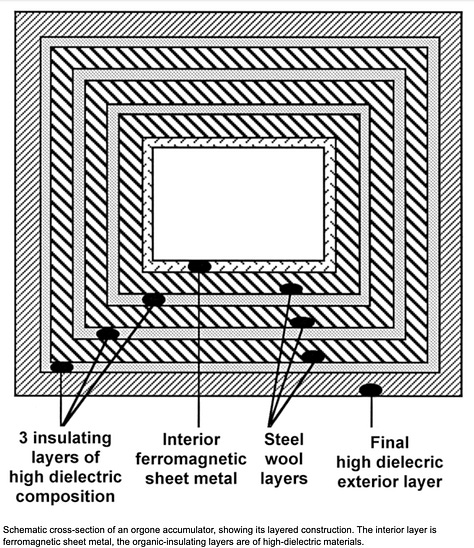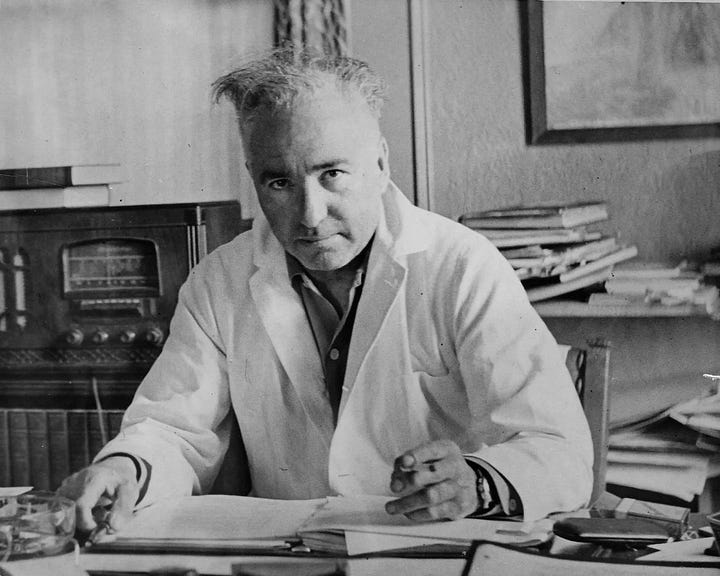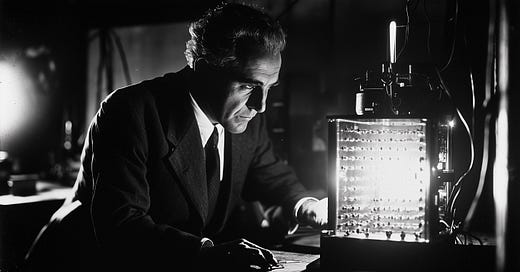Orgone Outlaw: Reich's Cosmic Truth Bomb They Tried to Bury
Persecuted and ultimately destroyed for his radical ideas, Reich's work, once dismissed as pseudoscience, may hold the key to a revolutionary understanding of the universe and our place within it.
Wilhelm Reich (1897-1957) found himself a target of not one, but two totalitarian regimes. His books and therapeutic inventions, burned by both the Nazis and the post-WWII American intelligence community, contained material dangerous to authoritarian regimes.
Reich is synonymous with both genius and controversy, conjuring images of a scientific renegade, a sexual revolutionary, who not just kept talking about a mysterious energy called "orgone,” but also built contraptions to capture it.
Orgone Accumulators1 were boxes of wood and metal that looked like something out of a B-movie, yet Reich claimed they could heal the sick and influence the weather. The establishment laughed, of course. They called him a madman. But what if, just what if, he was onto something?
The Orgone Enigma: Sex, Lies, and Cosmic Energy
Reich, who began his career as Freud's golden boy, had a mind that wouldn't quit. But where Freud saw the psyche as a battlefield of repressed desires, Reich saw raw, potent energy. He became fixated on the orgasm, not just as a pleasurable act, but as a fundamental expression of this life energy. In Vienna, in the roaring '20s, this was radical stuff. His 1927 book, Die Funktion des Orgasmus, went beyond Freud, tying sexual energy to a broader, cosmic force. Big career mistake.
The 1930s weren't exactly known for their open-mindedness when it came to sex, or anything else. Any talk that didn't fit the rigid societal norms was deemed dangerous, subversive. Reich's association of life force with sexuality, his bold pronouncements on the orgasm as a release of "orgone" was a live handgrenade.
It was a time of rising fascism, of rigid control, and Reich's ideas about a free-flowing, orgasmic universe were anathema to the power structures that thrived on repression. The Nazis, with their obsession with purity and control, burned his books. They saw his work on sexual liberation as a threat to their foundation. Reich was an enemy of the state, a corrupter of the youth, a dangerous lunatic who needed to be silenced.
The American Nightmare: From Freud's Prodigy to Public Enemy
Fleeing the Nazi storm, Reich sought refuge in the United States, landing in 1939, hoping for a more receptive audience. But America, in the throes of its own brand of puritanical paranoia, wasn't much better. The land of the free, it turned out, wasn't so free when it came to ideas that challenged the established order.
Reich's orgone accumulators were seen as a dangerous fraud. The FDA took him to court, not for failing to prove his claims, but for daring to make suggestions that the machines had healing potential for diseases like cancer (the 1910 Rockefeller commissioned Flexner Report had already dictated the banning of alternative medicine in favor of pharmaceutical drugs).
The early 1940s was the pinnacle era of Allen Dulles, the Machiavellian spymaster who headed the CIA and saw enemies everywhere. Under Project Paperclip, Dulles imported Nazi scientists, some with deeply disturbing pasts, into the heart of the American intelligence and scientific communities. Men like Hitler's personal hypnotist, Ferenc Völgyesi, a war criminal who'd conducted experiments on concentration camp prisoners, were given new identities and put in charge of mind control research. In this climate of fear and twisted loyalties, Reich, with his anti-Nazi past and his revolutionary ideas, was a threat. His books, once burned by the SS, were now destroyed by the FBI, the irony as thick as the smoke in a backroom poker lounge.
After Reich was arrested and incarcerated, his notes were stolen and his orgone machines demolished. Reich died in his cell in 1957 of heart failure, a suspiciously convenient end for a man who had become a thorn in the side of the establishment.
The Plasma Connection: A Universe of Intelligent Energy
Luckily, Reich wasn't alone in his cosmic quest. Other brilliant minds, usually operating at the fringes of mainstream science, were reaching similar conclusions. Decades after Reich's death, these musings were classified under a novel scientific term: plasma physics.
The new champions joined the Sisyphean grind of demolishing widely accepted dogmas. Before and since their time, most of what we know about plasma physics has been suppressed or classified. The reason is clear: there is too much information here that could disrupt our governing structures and the foundation of modern science.
Today we know that universe is 99% plasma, a state of matter composed of charged particles that interact in complex, seemingly intelligent ways. Plasma forms vast cosmic filaments, generates electromagnetic fields, and self-organizes into intricate structures without any central control.
As Robert Temple elucidates in his groundbreaking work, A New Science of Heaven2, this sounds an awful lot like Reich's orgone. A universal, self-organizing energy that permeates everything, driving the cosmos not through blind force but through an inherent intelligence. The parallels are uncanny. The very fabric of space, as described by modern physics, behaves remarkably like the life force that Reich was ridiculed for championing.
Interestingly, Reich often incorporated the sun into his orgone experiments, recognizing its potential as a powerful source of orgone energy. Given that the sun itself has been lately recognized a massive ball of plasma, this approach aligns with Reich's broader ideas about orgone energy.
The Silenced Voices: Dirac, Bohm, and the Hungarian Firebrand
The other luminaries who followed Reich's work, including Nobel Prize-winning physicist Paul Dirac, had their work cut out for them. According to Temple, Dirac confessed over a cup of tea his deep fascination with biology, a field he felt was far more vibrant than the increasingly rigid world of physics. Dirac’s sentiment was typical for norm-breaking scientists. The compartmentalization of physics vs biology, for example, only begins to make sense once we understand how field regulates form - way before chemistry has a say in the matter.
Dirac's work on magnetic monopoles, hypothetical particles with a single magnetic pole, also resonated with Reich's ideas about the fundamental polarity of orgone energy. It seemed like even this giant of quantum physics was looking for something more, something beyond the accepted paradigms.
Temple also recounts his interactions with David Bohm, another renegade physicist known for his alternative interpretation of quantum mechanics. Bohm, when asked about the "quantum potential," a key element in his theories, admitted that he didn't know what it actually was. He could describe its effects mathematically, but its true nature remained a mystery. This candid admission, coming from one of the most respected physicists of the 20th century, is a stark reminder that even the most advanced scientific theories are often groping in the dark.
Both of these men were hinting at the same thing that Reich tried to show with his orgone theory: there are forces at play that are not immediately visible, forces that the establishment is hell-bent on keeping hidden.
Then there was Albert Szent-Györgyi, the Hungarian biochemist who discovered Vitamin C and later turned his attention to the electrical nature of life. His books, Bioenergetics and Bioelectronics, were bombshells, arguing that living organisms function like complex electronic circuits, with energy flowing in a way that resembles the behavior of plasma. He even spoke of an "electron gas" pervading every molecule in the body, a concept that aligns remarkably well with the modern understanding of plasma as a fundamental component of living systems. He, too, had fled Europe and was leading a resistance against the Nazis, after showing how cancer could be linked to failures or malfunctions in the body's electrical or electronic system. He narrowly escaped being captured, tortured, and killed by the Gestapo. Hitler himself had ordered a warrant for his arrest.
Szent-Györgyi, like Reich, was a refugee from authoritarianism, and his ideas about the electrical nature of life were met with the same kind of resistance in America. He was marginalized, denied funding, and relegated to a backwater research position at the Marine Biology Lab in Woods Hole. It was as if the American scientific establishment was afraid of what he might uncover, afraid of the implications of his work.
And there was Nobel laureate Ilya Prigogine, who boldly stated that science was only at its beginning, not its end. He emphasized the complexity of nature, particularly in biological systems, and admitted that even with advancements like understanding the gene structure, the deeper meaning of life remained elusive. Prigogine's perspective aligns with Reich's in acknowledging the vast unknown and the limitations of current scientific paradigms in grasping the full picture of reality.
Freeman Cope: The Fed Who Said Reich Was Right (But Keep it on the Down-Low)
Perhaps the most intriguing part of this whole saga is the story of Freeman Cope. Cope was a biochemist working for the Office of Naval Research, the very agency that had seized Reich's papers after his arrest. And what was Cope's task? To evaluate those papers, to determine if there was anything to Reich's "crazy" ideas.
As Robert Temple reveals, Cope spent a quarter of a century studying Reich's work in a Navy Intelligence lab. And his conclusion? Reich was probably right.
Cope found evidence that orgone energy might indeed exist, not as some mystical force, but as a manifestation of plasma, behaving in accordance with the principles of electromagnetism. He even proposed mechanisms, involving superconductivity and Josephson Junctions (interfaces that allow for the control of electrical currents), that could explain how orgone accumulators might actually work.
Cope's work, quietly published in obscure journals, was a time bomb. It suggested that the U.S. government, while publicly denouncing Reich, was secretly investigating his theories and finding them potentially valid. It was a classic case of "do as I say, not as I do."
The implications were staggering. If Reich was right, then our understanding of life, energy, and the universe was fundamentally incomplete.
The Detective Work Continues: Unraveling the Cosmic Tapestry
Reading into Reich's life and work feels like piecing together a fragmented mosaic, a picture of a universe far more dynamic and interconnected than we've been led to believe. The suppressed voices of Reich, Dirac, Bohm, and Szent-Györgyi, along with the hidden research of Freeman Cope, all point to a reality where energy, not matter, is the fundamental building block.
This isn't just about some abstract scientific theory. It has profound implications for how we live our lives. Reich believed that neuroses and disease were the result of blocked orgone energy, a stagnation of the life force. He saw the orgasm as a crucial mechanism for releasing this energy, for restoring balance and wholeness. If we translate this into the language of modern science, we can see a clear connection to the concept of maintaining a healthy flow of energy within our bodies. Whether we call it orgone, chi, prana, or simply bioelectricity, the principle is the same: free and unobstructed flow is essential for well-being.
Practices like meditation, yoga, and martial arts, which have been used for centuries to cultivate and harmonize energy flow, can be seen as practical applications of Reich's ideas. The ultimate power lies in authentic living, free from the constraints of norms and expectations, with the courage to forge one's own path, even an irrational one. Anything to get us to “flow freely.”
The potential implications for society are even grander.
A Decentralized Universe: The End of the Control Paradigm
If the universe is inherently intelligent, if it self-regulates through the dynamic interplay of energy, then what need is there for rigid hierarchies, for centralized authority, for the kind of top-down control that governments and corporations so desperately cling to?
Reich's ideas, coupled with the insights of plasma physics, point towards a decentralized model of existence as the only form that is natural to life. A model where power resides not in the hands of a few, but is distributed throughout the entire system, where every individual is a node in a vast, interconnected web that is looking to evolve, rather than control. To manifest, rather than pose. To share, rather than own. To contribute, rather than acquire.
Reich's vision means we can build societies that are free. Equitable. Fair. That we don't need complex control systems to attempt to contain society - except for the benefit of a handful of psychopaths.
The Future's Electric: Orgone, Plasma, and Our Cosmic Getaway
Reich's story is a warning flare. They silenced him, burned his books, and got rid of him. But his truth, like a stubborn weed, is cracking through the concrete - today more than ever. He was a cosmic gumshoe, chasing clues that led him to a universe far more alive and orgasmic than a handful of control freaks could ever stomach.
Now, as the same group tries to tighten its grip with digital chains under the guise of a One World Government and CBDCs, the ultimate outcome of centralization, Reich's vision is more vital than ever. The future requires a jailbreak on a cosmic scale, and understanding Reich's principles and history may be the skeleton key.
We're not just cogs in a machine, but free agents in a cosmic dance. The clock's ticking, the fight's on, and the universe, if Reich was right, is waiting to see if we've got the guts to join the party.
Postscript - AI on Reich
As I was researching the often hard-to-find material on Reich, I came across an archive with 122 volumes3 spanning over a half century. I imported the data into Gemini AI in order to break down the material. A part of this feature was a discussion by two AI avatars about the gist of this material, which in parts is quite interesting to observe. The copy of the 30 minute AI “podcast” can be found below, along with the rest of the source material.
ORGONE ACCUMULATOR







Temple, Robert. A New Science of Heaven: How the new science of plasma physics is shedding light on spiritual experience. Hodder & Stoughton.
Internet Archive - Wilhelm Reich - Complete Collection
OTHER LITERARY SOURCES:
Books by Wilhelm Reich:
The Function of the Orgasm (1927, English edition: 1942)
Focuses on his early psychoanalytic theories and the concept of "orgastic potency."Character Analysis (1933, English edition: 1945)
A foundational work in psychoanalytic therapy exploring character structures.The Mass Psychology of Fascism (1933, English edition: 1946)
Examines the psychological roots of fascist ideologies.The Sexual Revolution (1936, English edition: 1945)
Advocates for sexual freedom as essential to societal health.Listen, Little Man! (1948)
A critique of societal conformity and authoritarianism.The Cancer Biopathy (1948)
Part of his series The Discovery of the Orgone, delving into biophysical energy and disease.Ether, God and Devil / Cosmic Superimposition (1949)
Explores metaphysical aspects of orgone energy.People in Trouble (1953)
A semi-autobiographical exploration of Reich's conflicts with societal norms.Contact with Space (1957)
Discusses Reich's experiments with orgone energy and UFO phenomena.
Posthumous Collections:
Selected Writings: An Introduction to Orgonomy (1961)
A curated collection of Reich’s writings on various subjects.Beyond Psychology: Letters and Journals, 1934-1939 (1994)
Insights into Reich’s personal and intellectual life during critical years.American Odyssey: Letters and Journals, 1940-1947 (1999)
Covers Reich's time in the United States and his development of orgonomy.Passion of Youth: An Autobiography, 1897-1922 (1988)
An account of Reich’s early life and influences.
Notable Biographies and Books About Wilhelm Reich:
Wilhelm Reich: The Evolution of His Work by David Boadella (1973)
A detailed analysis of Reich’s intellectual journey.Fury on Earth: A Biography of Wilhelm Reich by Myron Sharaf (1983)
A comprehensive and empathetic biography.Wilhelm Reich and Orgonomy by Ola Raknes (1970)
Explores Reich’s theories and their practical applications.The Assault on Truth: Freud's Suppression of the Seduction Theory by Jeffrey Moussaieff Masson (1984)
Includes analysis of Reich’s challenges to Freud's theories.Reich Speaks of Freud by Wilhelm Reich (1967)
A retrospective on Reich’s relationship with Freud and psychoanalysis.






The Taoists know it as the Tao. Consciousness, or self-organising energy, or plasma if you prefer, has been recognised as the ground of the universe by a few for a long time, by some for centuries. This knowledge doesn't add to scientific materialisms understanding of the universe, it completely contradicts it.
Jailed for thinking......not far behind and not far ahead...
https://educate-yourself.org/ct/goodbyects10jan02.shtml#top
https://educate-yourself.org/ct/
https://mirkokulig.com/video-easy-to-build-small-orgone-accumulator-tutorial/
https://mirkokulig.com/recommendations-of-use-for-the-orgone-energy-blanket/
https://mirkokulig.com/how-to-build-an-orgone-energy-blanket/